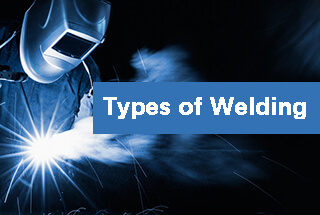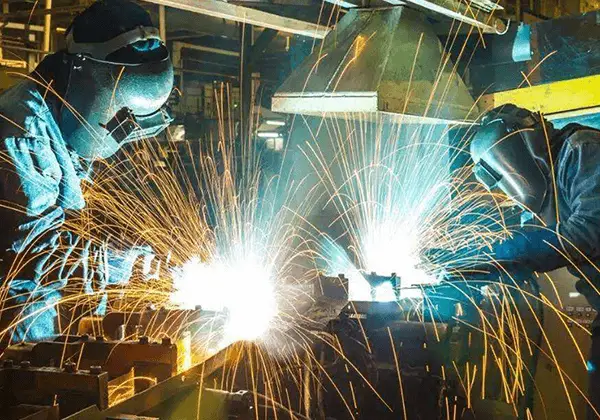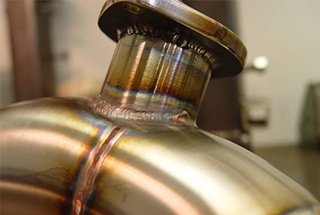Although aluminum and its alloys are widely used in welding important products, they are not without difficulties in actual welding production. Some of the main issues include porosity in the weld, hot cracks during welding, and achieving equal joint strength.
One of the reasons for these issues is the strong chemical activity of aluminum and its alloys, which makes the surface very prone to forming oxide films that are often refractory. For example, the melting point of Al2O3 is 2050 ℃, and the melting point of MgO is 2500 ℃. Additionally, aluminum and its alloys have high thermal conductivity, making it easy to experience non-fusion during welding.
The oxide film, which has a density similar to that of aluminum, can become inclusions in weld metal. Furthermore, the less dense oxide film with MgO can absorb more water and is often a significant cause of weld porosity. Additionally, aluminum and its alloys have a large linear expansion coefficient and high thermal conductivity, making them prone to warp deformation during welding.
Finally, the article analyzes the relatively serious cracks that occur during testing.
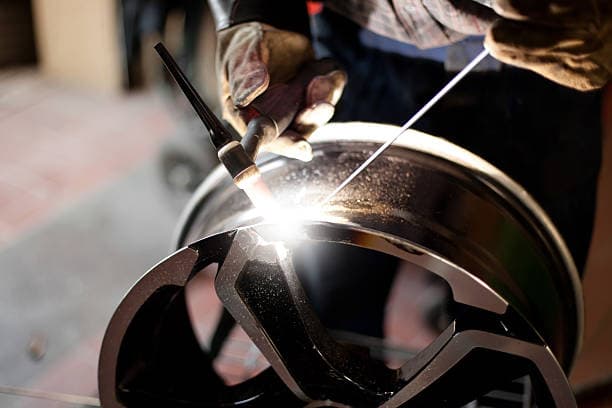
1. Cracks in aluminum alloy welded joints and their characteristics
During the aluminum alloy welding process, various cracks can appear in the welded joints due to differences in the types, properties, and welding structures of materials.
The shape and distribution of these cracks can be quite complex.
Based on their location, these cracks can be divided into two types:
(1) Cracks in weld metal: longitudinal cracks, transverse cracks, crater cracks, hairlike or arc cracks, root cracks and microcracks (especially in multi-layer welding).
(2) Cracks in the heat affected zone: weld toe cracks, lamellar cracks and micro thermal cracks near the fusion line.
Cracks generated during welding can be categorized into hot cracks and cold cracks, based on the temperature range at which they occur.
Hot cracks occur at high temperatures during welding and are primarily caused by the segregation of alloy elements on the grain boundary or the presence of low melting point materials.
The shape, temperature range, and primary causes of hot cracks vary depending on the materials of the welded metal.
The hot cracks can be divided into three types: crystallization cracks, liquefaction cracks and polygonization cracks.
Crystallization cracks mainly occur during the welding process at high temperatures. Near the solidus, the solidified metal shrinks, causing insufficient residual liquid metal that cannot fill in time, leading to the generation of cracks.
Intergranular cracking occurs due to solidification shrinkage stress or external force, mainly in carbon steel, low-alloy steel welds, and some aluminum alloys with more impurities.
Liquefaction cracks occur due to the shrinkage stress during solidification of grain boundaries heated to high temperatures in the heat-affected zone.
In testing, it was discovered that insufficient cleaning of the filler material surface resulted in the presence of inclusions and pores in the weld after welding. In the three-group number test, since the welding filler material is a cast structure, and the inclusion is a high melting point material, it remains in the weld after welding.
The casting structure is relatively sparse, with many holes, making it easy to absorb components containing crystal water and oil quality. These factors can cause porosity during welding, and inclusions and pores become key parts that induce microcracks when the weld is under tensile stress.
Further observation by a microscope revealed an interaction between these inclusions and microcracks induced by pores. However, it is challenging to determine whether inclusions mainly act as a stress concentration source to induce cracks or a brittle phase to induce cracks.
Moreover, it is widely believed that porosity in aluminum-magnesium alloy welds does not significantly affect the weld’s tensile strength. However, this study found microcracks induced by inclusions and porosity in the weld tensile samples simultaneously.
Whether microcracks induced by pores are a secondary associated phenomenon or one of the primary factors that cause a significant decline in the tensile strength of welds needs further study.

2. Process of hot crack generation
Currently, the theory of welding hot cracks, as proposed by Prokhorov both domestically and internationally, is considered to be highly refined.
To summarize, the theory suggests that the generation of crystal cracks primarily depends on the following three factors:
- The size of the brittle temperature range
- The ductility of the alloy within this temperature range
- The deformation rate of the metal when in the brittle temperature range
The size of the brittle temperature range and the ductility value within this range are commonly referred to as metallurgical factors that can produce welding hot cracks, whereas the deformation rate of the metal within the brittle temperature range is known as a mechanical factor.
The welding process involves a series of unbalanced technological procedures. This characteristic is closely linked to the metallurgical and mechanical factors of metal fracture in welded joints, such as physical, chemical, and organizational heterogeneity, slag and inclusions, gas elements, and vacancies with supersaturated concentrations of the products of the welding technological and metallurgical processes.
All of these factors are closely related to the initiation and development of cracks in metallurgy.
In terms of mechanical factors, the specific temperature gradient and cooling rate of the welding thermal cycle can cause the welded joint to be in a complex stress-strain state under certain constraint conditions, which provides necessary conditions for the initiation and development of cracks.
During the welding process, the combined effect of metallurgical and mechanical factors can either strengthen or weaken the metal connection in two ways.
If a strong connection is established in the welded joint metal during cooling, the strain can remain obedient under certain rigid constraint conditions. When the weld and the metal near the seam can withstand external constraint stress and internal residual stress, cracks are less likely to occur, and the metal’s crack sensitivity is low.
On the other hand, if the stress cannot be withstood, the strength connection in the metal is more likely to be interrupted, resulting in cracks. In this case, the weld joint metal’s crack sensitivity is high.
The weld joint metal is cooled to room temperature at a certain rate from the temperature of crystallization solidification. Its crack sensitivity depends on the comparison of deformation capacity and applied strain, as well as the comparison of deformation resistance and applied stress.
However, during the cooling process, different temperature stages may result in different intergranular strength and grain strength growth, different deformation distribution between and within grains, different diffusion behavior induced by strain, different stress concentration conditions, and factors leading to metal embrittlement. These can cause different specific weak links in welded joints, and the degree to which they weaken may also vary.
The occurrence of cracks in the weld joint metal is closely related to both metallurgical and mechanical factors.
The stress gradient in mechanical factors is related to the temperature gradient, which is determined by the thermal cycle characteristics. The thermal conductivity of the metal determines the thermal cycle characteristics, which are considered as metallurgical factors. These include the metal’s thermoplastic change characteristics, thermal expansion, and structural transformation.
The stress-strain state of the welded joint metal is greatly influenced by both metallurgical and mechanical factors. Furthermore, these factors undergo changes as the temperature decreases and cooling speed changes.
Different temperature ranges affect the strength of welded joint metal differently. For instance, the large crystallization temperature range and low solidus temperature are likely to cause stress concentration at the residual low melting liquid metal between grains, leading to cracks in the solid metal. Similarly, if the shrinkage is large, especially under the condition of rapid cooling, cracks are likely to occur when the shrinkage strain rate is high and the stress-strain state is harsh.
During the later stage of solidification and crystallization of weld metal during aluminum alloy welding, eutectic is squeezed in the center of crystal intersection to form a “liquid film.” At this point, due to the large shrinkage during cooling, free shrinkage is not available to generate large tensile stress. As a result, the liquid film forms a weak link, which may crack in the weak zone under the effect of tensile stress.
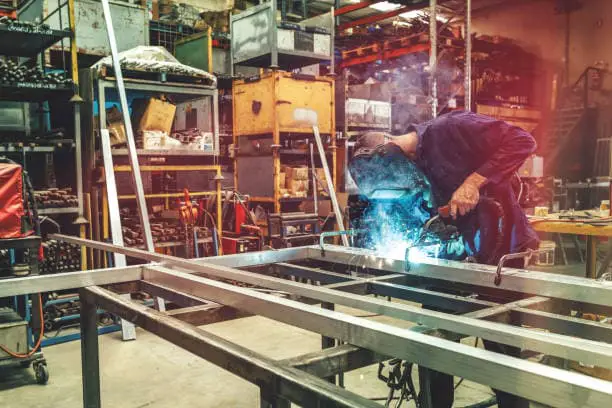
3. Mechanism of hot cracks
To investigate the occurrence of hot cracks in aluminum alloy welding, the crystallization process of the welding pool is classified into three stages.
The first stage is the liquid-solid stage, during which a small number of crystal nuclei exist as the welding molten pool starts to cool from high temperature. As the temperature drops and cooling time extends, the crystal nuclei gradually grow and new ones emerge.
However, the liquid phase still predominates and there is no contact between adjacent grains, which allows for the free flow of the liquid aluminum alloy that has not yet solidified. Hence, even under tensile stress, any opened gaps can be filled promptly by the flowing liquid metal, making the likelihood of cracks in this stage very small.
The second stage is the solid-liquid stage. Here, the solid phase in the molten pool continues to increase as crystallization progresses, and the previously formed crystal nuclei continue to grow.
When the temperature drops to a certain point, the solidified aluminum alloy metal crystals come into contact with each other and continuously roll together. At this stage, the flow of liquid aluminum alloy is blocked, and the molten pool crystallization enters the solid-liquid phase.
Because of the small amount of liquid aluminum alloy metal, the deformation of the crystal itself can be strongly developed at this stage, and the residual liquid phase between the crystals is not easy to flow.
The tiny gaps generated under tensile stress cannot be filled, and even a little tensile stress can lead to the possibility of cracks. This stage is known as the “brittle temperature zone.”
The third stage is the complete solidification stage. When the weld formed after the molten pool metal is completely solidified is subjected to tensile stress, it shows good strength and plasticity, and the likelihood of cracking at this stage is relatively low.
Therefore, when the temperature is higher or lower than the brittle temperature zone between a-b, the weld metal has a greater resistance to crystal cracks and a smaller crack tendency. In general, for metals with fewer impurities (including base metal and welding materials), the brittle temperature range is narrow.
The tensile stress acts in this range for a short time, so the total stress of the weld is relatively small, resulting in a lower tendency for cracks to develop during welding.
However, if there are many impurities in the weld, the brittle temperature range is relatively wide, and the action time of tensile stress in this range is relatively long, leading to a greater tendency to produce cracks.
4. Prevention measures for aluminum alloy welding cracks
To reduce the probability of hot cracks in aluminum alloy welding, improvement can be made through two aspects: metallurgical factors and technological factors.
Regarding metallurgical factors, preventing intergranular hot cracks during welding involves adjusting the weld alloy system or adding modifiers to the filler metal.
To control an appropriate amount of fusible eutectic and narrow the crystallization temperature range from a crack resistance perspective, the focus of the weld alloy system needs adjustment.
As aluminum alloy is a typical eutectic alloy, the “maximum” solidification temperature range of the alloy corresponds to the maximum crack tendency.
The presence of a small amount of fusible eutectic always increases the solidification crack tendency. To counter this, the content of main alloy elements is typically increased beyond the alloy component with the maximum crack tendency to produce a “healing” effect.
Additionally, trace elements such as Ti, Zr, V, and B are added to the filler metal as modifiers in an attempt to improve the plasticity and toughness by refining the grains and preventing welding hot cracks. This attempt has been ongoing for some time and has yielded positive results.
Figure 3 depicts the crack resistance test results of Al-4.5% Mg welding wire with a modifier under the condition of a rigid lap fillet weld. The test included the addition of 0.15% Zr and 0.1% Ti+B. The results indicate that the simultaneous addition of Ti and B significantly improved crack resistance.
Ti, Zr, V, B, and Ta share a common feature in that they can react with aluminum to form a series of peritectic reactions, resulting in the formation of refractory metal compounds such as Al3Ti, Al3Zr, Al7V, AlB2, Al3Ta, etc.
These small refractory particles can act as non-spontaneous solidification crystal nuclei during the solidification process of liquid metal, thereby facilitating grain refinement.
Process factors such as welding specifications, preheating, joint form, and welding sequence are crucial to solving welding cracks, which are based on welding stress. Welding process parameters impact the non-equilibrium of the solidification process and solidification structure state, as well as the strain growth rate during solidification, thereby influencing the formation of cracks.
Welding methods that employ concentrated heat energy facilitate rapid welding and can prevent the formation of coarse columnar crystals with strong directivity, thereby improving crack resistance.
Reducing the welding speed and employing a small welding current can decrease the overheating of the molten pool and improve crack resistance. Increasing the welding speed, however, increases the strain rate of welded joints and the tendency of hot cracking. Therefore, it is evident that increasing the welding speed and welding current increases the crack tendency.
During the assembly and welding of aluminum structures, the weld does not bear much stiffness. As such, measures such as sectional welding, preheating, or reducing welding speed can be taken.
Preheating can reduce the relative expansion of the specimen and consequently decrease welding stress, which reduces stress in the brittle temperature range. Butt welding with groove and small gaps should be employed as much as possible, while cross-joint and improper positioning and welding sequences should be avoided. When welding is completed or interrupted, the crater should be filled immediately, and the heat source removed, or else crater cracks may easily occur.
During the welding of multi-layered welded joints of 5000 series alloys, microcracks frequently occur due to local intergranular melting, necessitating the control of the welding heat input of the next layer of weld bead.
Based on the findings of this paper, surface cleaning of the base metal and filler material is crucial for aluminum alloy welding. Materials inclusion becomes the source of cracks in the weld and the primary reason for the decline of weld performance.
